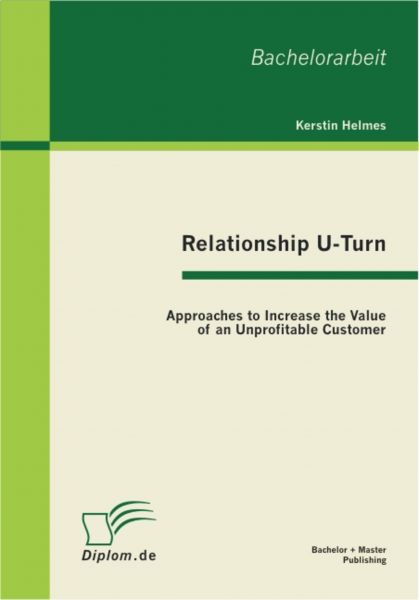Relationship U-Turn: Approaches to Increase the Value of an Unprofitable Customer
Customer relationship management concentrates to a great extent on the profitable customers and how to enhance their profitability. Little insight has been given on how to treat the "wrong" customer. This literature research paper shows that customer profitability and overall firm profitability can be improved when dealing with unprofitable customers. The managerial approaches discussed focus on maintaining the customer relationship. For this reason, this paper differs from the general widespread strategy of termination or "firing" an invaluable customer.
First, relationship marketing and "Relationship U-turn" are introduced in this paper. Second, customer value and methods of measuring customer value are discussed. The body of this paper concentrates on different approaches that try to turn unprofitable customer relationships into profitable ones. Some of the approaches focus on letting the customer take over more of the value chain activities such as self-service. Other approaches look more at the non-monetary value a customer can provide such as positive word-of-mouth. Examples from business-to-business (B2B) and business-to-consumer (B2C) markets are given for each approach and discussed in detail. The paper concludes with ideas for future research and a discussion. It emphasizes that companies need to realize that every customer is an asset that contributes to the value of a firm. However, customers differ in their needs and a company has to tailor its offering to meet these needs. Only when a company takes a more customer-centric view can it be successful, especially in mature markets.
Customer relationship management concentrates to a great extent on the profitable customers and how to enhance their profitability. Little insight has been given on how to treat the "wrong" customer. This literature research paper shows that customer profitability and overall firm profitability can be improved when dealing with unprofitable ...
Textprobe:
Kapitel 2.1, Customer Relationship Management (CRM):
Customer relationship management has its roots in relationship marketing. The bases are relationship orientation, customer retention and achieving a high customer value created through process management. CRM is defined as the "values and strategies of relationship marketing - with particular emphasis on customer relationships - turned into practical application". Hereby IT is one key element. A data warehouse, where information about customers is stored, enables retailers to collect data, learn about their customers and tailor future marketing initiatives.
Thanks to technology, customer management has become an easier task. A company can now assess a customer’s profitability on an individual level. Many service companies such as airlines, telecommunication companies and financial institutions use customer relationship management software to increase the lifetime value of a customer "by matching products and levels of service more closely to a customer’s expectations".
Usually, the usage of CRM systems has lead to firms "cherry-picking only profitable customers" and concentrating all their marketing efforts on the most valuable customers. The emphasis has been on maintaining long-term relationships with these customers. Companies treat valuable customers like royalty or the cream of the crop and go to great lengths to retain them. Take for example the airline company Lufthansa. In 2004 travelers, who collected 600,000 frequent flyer miles over the course of the last two years could join the HON circle program. These clients enjoy perks such as limousine pick up, guaranteed booking, and check-in at special first class terminals.
However, only a small minority of customers are truly profitable. A well known fact, the Pareto Principle, states that 20 % of the customers are responsible for 80% of the sales revenue. Companies in both B2B and B2C markets have a large base of so called "unprofitable customers". A company’s client is unprofitable if he possess a "negative contribution margin" which is the generated revenue minus the direct costs and cost-to-serve. This means that an unprofitable customer costs more than he is worth. A survey conducted in the German mechanical engineering sector showed that about one fifth of the companies possess a customer portfolio in which more than half of their customer are unprofitable. In a business-to-consumer setting, a German retail bank identified 26.8% of its customers to be unprofitable. Yet, management of unprofitable customers has mainly been reduced to "demarketing" or termination of the relationship.
Many authors suggest termination as "the way" to deal with unprofitable customers. Termination is when a company severs ties to a customer. The seller no longer wants to engage in business with a certain customer because he no longer sees a value in continuing the relationship. It can make sense not to keep customers who don’t pay bills on time, or who constantly call the service hotline. The same would be industrial firms who change their mind on quantity or quality of deliveries. Zeithaml et.al. see firing customers as a possibility to increase profitability because a company no longer has to use their resources to serve these customers and instead can employ them more effectively.
Kerstin Helmes was born in 1987 in Lexington, Kentucky. She grew up bilingually, speaking German and English, and later moved to Berlin, Germany. Here, she began her business studies at the Freie Universität. After a year abroad she recieved her Bachelor’s of Science in Business Administration. During her studies Kerstin obtained practical work experience through various internships at Manpower Engineering, an NH Hotel and a hospital. She also worked for the Kentucky Education Television Network. All of these experiences taught her about companies and their customers which motivated her to write this paper. Presently, she is doing her Masters in Munich.
Versandkostenfreie Lieferung! (eBook-Download)
Als Sofort-Download verfügbar
- Artikel-Nr.: SW9783863415594
- Artikelnummer SW9783863415594
-
Autor
Kerstin Helmes
- Wasserzeichen ja
- Verlag Bachelor + Master Publishing
- Seitenzahl 50
- Veröffentlichung 01.07.2011
- ISBN 9783863415594
- Barrierefreiheit Aktuell liegen noch keine Informationen vor

